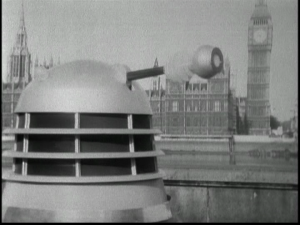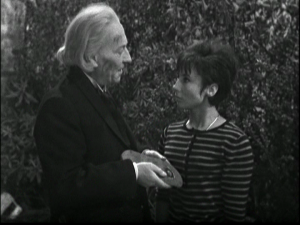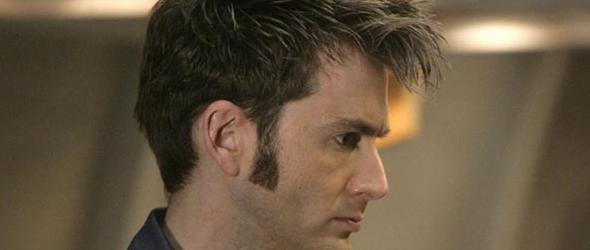 If not for the Daleks, odds are we wouldn’t be celebrating fifty years of Doctor Who. The series might have run a bit beyond its initial 13-episode order and been fondly remembered by a small segment of fans, but odds are it wouldn’t be the recognizable world-wide icon that it is today.
If not for the Daleks, odds are we wouldn’t be celebrating fifty years of Doctor Who. The series might have run a bit beyond its initial 13-episode order and been fondly remembered by a small segment of fans, but odds are it wouldn’t be the recognizable world-wide icon that it is today.
And, yes, the Daleks almost didn’t happen. Several other stories had to fall through to get the Terry Nation, six-part story into the production rotation and then producer Verity Lambert had to fight her bosses to get the original serial on the air. The production itself also saw problems with the first episode having to be recorded twice (something that rarely happened in this era of the BBC) and the serial extended an extra episode.
Thankfully, all those things came together, the Daleks appeared and the rest is, as they say, history. From their first moment on screen, the Daleks left a mark on the memory and imagination of the British viewing public and after the huge ratings for that first seven-part story, a return appearance was inevitable.* It took a year to bring them back and the production team decided to go for something really special to herald their return — a six part story that saw the Daleks invading Earth in the far future. Filmed as the first serial of the second season, the story is one that’s full of firsts, including the first time a monster had returned, the series first use of location shooting and the break-up of the original TARDIS crew.
*Despite the fact that the Daleks were originally intended as a one-time adversary for the Doctor and company. The metal pepperpots are pretty much left for dead and defeated by the time we reach the final segment of the original Dalek story.
It wouldn’t be a look at the William Hartnell era without checking in on the monsters that helped define that era. This time around, we set the DVD player up to bring us “The Dalek Invasion of Earth.”
Hickerson: Watching “The Daleks,” it’s pretty apparent that Terry Nation and the rest of the production team thought that the Daleks would be a one-shot monster. That original seven-part story is less about the Daleks wanting to subjugate and conquer the universe as much as it was about two groups fighting for the right to survive on a far-flung future world. Even in that first story, the Daleks are given the weakness of needing metal floors to move around and not being able to venture much outside their city. So, here we are a year later and they’re back, invading Earth and apparently not needing metal floors to glide around and conquer things. Later stories will slowly disregard the initial continuity and need for metal floors, but it’s interesting to see how hard Terry Nation works here to explain how the Daleks can still be around and conquering a future version of world.
Ragunton: I have an odd time when dealing with the return of the Daleks in this story. While I appreciated the fact that they were brought back after their enormously popular premiere the year before, I find it difficult to divorce myself of all the Dr. Who knowledge I possess and regard this story much the same way a viewer did back in 1964. The excuse that the Doctor gives to Ian sounds great on the surface, knowing all that I do about the Daleks does tend to make that reasoning from the Doctor a bit hard to swallow. Again, that’s only because of all the myriad of Dalek episodes that I’ve watched from Jon Pertwee on to the present day. I suppose a rationalization could be made that because the Doctor has such limited experience with the Daleks at this time in his life that he is merely surmising past (Or future?) turn of events.
Hickerson: I think one thing we forget is that these serials weren’t meant to be repeated. If you missed it, you missed it. There weren’t repeat showings and it was decades before VHS or DVD. The only way to re-experience the story was the eventual Target novel or the big-screen movie (more on that later). So, yes, the continuity is fairly loose — even up to the Pertwee era and beyond. One good way to give yourself a headache is to try and figure out a timeline for all the Dalek stories (especially given the contradictions and that they invent time travel in the next story). And we haven’t even got to the implications of “Remembrance of the Daleks” and that the Doctor knew what was out there on Skaro….
One thing that I really like about this story is the location filming. It was the first time (beyond some cutaways for “The Reign of Terror”) that the production team ventured outside the studio. The story started the trend of various alien forces invading London in the era and seeing iconic monsters at familiar locations through out the city. Watching the Dalek rise from the Thames, it’s easy to see why moments like these created such an impression on viewers and fans of that era.
 Ragunton: I thought seeing the Daleks come out of the Thames as not only a powerful and chilling image, but for me it helped to cement the idea that this was a force clearly to be reckoned with. Given how the last time we saw them they were bound to the metal floors of their city on Skaro, seeing them come out of the water in London is not just menacing. It is shocking! I couldn’t think of a greater way to re-introduce the Doctor’s deadliest adversaries than how it was done here. As for the rest of the episode, I’m sure there are some that might have felt the remaining part of the studio recordings with the Daleks as rather anti-climactic, but that wasn’t the case with me. It served to reinforce throughout all of the episodes that Daleks are dangerous and a threat to be reckoned with.
Ragunton: I thought seeing the Daleks come out of the Thames as not only a powerful and chilling image, but for me it helped to cement the idea that this was a force clearly to be reckoned with. Given how the last time we saw them they were bound to the metal floors of their city on Skaro, seeing them come out of the water in London is not just menacing. It is shocking! I couldn’t think of a greater way to re-introduce the Doctor’s deadliest adversaries than how it was done here. As for the rest of the episode, I’m sure there are some that might have felt the remaining part of the studio recordings with the Daleks as rather anti-climactic, but that wasn’t the case with me. It served to reinforce throughout all of the episodes that Daleks are dangerous and a threat to be reckoned with.
Hickerson: It also makes me eager to take a trip to London and view all the sites conquered the Daleks (and later the Cybermen and Autons). Of course, I also want to visit all the rock quarries that served as alien worlds for the series as well, but I have a feeling that’s just me and not of much interest to a lot of other people or fans.
Ragunton: I highly doubt that you are the first long time Who fan who wants to visit London and make a pilgrimage out of all of the Dr. Who location settings! It’s certainly right up there on my bucket list. Same goes with Paris and Spain, and perhaps even Monument Valley, but I think we should save that discussion for another time…
Hickerson: As if the return of the Daleks wasn’t iconic enough and the first use of location filming, “The Dalek Invasion of Earth” also features the first time a companion departs. In this case, it’s Carol Ann Ford as Susan Foreman, falling in love with David Campbell and deciding to stay with him. Foreman has later said she was unhappy with how little development Susan got and how the character was never quite as interesting as the original scripts and character outline called for. (If you watch “The Sensorities” you can see some of that potential and how things could have gone). I often wonder what it was like for fans watching back in 1964 to see the original TARDIS family breaking up. I will give the story a lot of credit — there are a couple of moments sprinkled in to set up the romantic attraction between David and Susan and her decision to stay behind doesn’t feel as out of left field as other companion departures.
Ragunton: Seeing Susan go is another one of those “mixed feelings” that I previously mentioned. Having witnessed a plethora of companions come and go, some of them quite disturbingly and sadly, I look at Susan’s departure merely the first in a long line of people who would travel with the Doctor for a time after which they would leave. I can only try to imagine that to someone seeing it for the first time back then it might have appeared as quite a surprise. It’s hard to know in that I don’t have many other British TV shows from that time to compare Dr. Who with, which makes it hard for me to determine if what we see here is the exception or the rule. I can only guess that seeing a companion of her position in the show (being the Doctor’s granddaughter) be the first to depart as something that must have felt terribly sad for anyone watching it back then. As for the method, it made a lot of sense especially in how the Doctor explains it to her. She was a child. Now she’s a woman and he realizes that she has feelings of love for David (which didn’t present itself as too much of a surprise to me), so instead of having her face the dilemma of choosing between himself and David, he makes the choice for her. It might be viewed as a bit harsh, but it’s handled well in that she was given a companion to live out her days with on Earth.
Hickerson: But it does open up all kinds of debate on is Susan really the Doctor’s granddaughter and the implications of her living out all the rest of her regenerations on Earth. But that is a debate that is probably never going to end until Moffat or someone else gives us a definitive answer. (And at this point, I don’t think they will because it will really polarize the classic series fan base).
This story helped cement Dalek-mania in the UK and led to two films starring Peter Cushing as Dr Who. Both films condense the original stories a bit and run about 90 minutes as opposed to close to two and a half hours. The biggest selling point for the films is they were in color. Both are easily available on DVD, though I’d recommend watching the serial first.
 Ragunton: I had said previously that my first Doctor Who was the Tom Baker premiere episode, “Robot.” While that is true, in terms of the TV series, it’s not true in terms of Dr. Who itself. I was first introduced to it from the movie “Daleks’ Invasion Earth: 2150 A.D.” with Peter Cushing. The movie had something of an impact on me as I was surprised by the nature of the police box, the use of time travel, the menaces that he had faced (namely the Daleks), as well as the Doctor himself. It was clearly something of an action film filled with a fair amount of light heartedness as well. After a time I became aware of the TV series, and as odd as it felt watching it after having seen the second of the Who movies, I shortly fell madly in love with it, including the story “The Dalek Invasion of Earth.” It was years later, after purchasing the two Who movies with Cushing on DVD, that I re-watched the remade movie, and while I was dazzled by the beautiful, rich color and high production quality, the overall movie experience was something of a disappointment. It has been said that the Doctor Who TV series was a children’s show (which is not correct as it was more of a “family” series given its initial placement between the shows for children and those for adults). While the series had a serious feel to it, the movie was nothing of the sort. It was all played up for laughs and action. From the very beginning there is something of a laugh when we see Susan reading a book of extremely advanced science. I know that this was done to show how terribly intelligent she was supposed to be, but the manner in which it was presented felt as if it was supposed to be for the sake of humor. There was also a scene where Tom Campbell had to pretend to be one of the Robomen, and instead he passed himself off more as a bumbling fool. There was none of that silliness going on with the series. I found that after having watched both, I would prefer to view the Dr. Who series, even with the cheap TV budget and poor production values. The story telling there is far superior to that of the movie.
Ragunton: I had said previously that my first Doctor Who was the Tom Baker premiere episode, “Robot.” While that is true, in terms of the TV series, it’s not true in terms of Dr. Who itself. I was first introduced to it from the movie “Daleks’ Invasion Earth: 2150 A.D.” with Peter Cushing. The movie had something of an impact on me as I was surprised by the nature of the police box, the use of time travel, the menaces that he had faced (namely the Daleks), as well as the Doctor himself. It was clearly something of an action film filled with a fair amount of light heartedness as well. After a time I became aware of the TV series, and as odd as it felt watching it after having seen the second of the Who movies, I shortly fell madly in love with it, including the story “The Dalek Invasion of Earth.” It was years later, after purchasing the two Who movies with Cushing on DVD, that I re-watched the remade movie, and while I was dazzled by the beautiful, rich color and high production quality, the overall movie experience was something of a disappointment. It has been said that the Doctor Who TV series was a children’s show (which is not correct as it was more of a “family” series given its initial placement between the shows for children and those for adults). While the series had a serious feel to it, the movie was nothing of the sort. It was all played up for laughs and action. From the very beginning there is something of a laugh when we see Susan reading a book of extremely advanced science. I know that this was done to show how terribly intelligent she was supposed to be, but the manner in which it was presented felt as if it was supposed to be for the sake of humor. There was also a scene where Tom Campbell had to pretend to be one of the Robomen, and instead he passed himself off more as a bumbling fool. There was none of that silliness going on with the series. I found that after having watched both, I would prefer to view the Dr. Who series, even with the cheap TV budget and poor production values. The story telling there is far superior to that of the movie.
Hickerson: I’ll agree that the TV serial is superior. But I think it’s easy to underestimate the impact the movies had. Even the Terrance Dicks adaptation of this story uses the motive and ending from the movie instead of the motive and ending here. (It’s pretty much the same, though there are some minor differences.) I think the thing that the series had going for it was that it treated the events as completely serious and real. There was no attempt to camp it up — several actors over the years have commented that what made classic Who work so well was that the actors approached it seriously. That’s why wobbly sets and men in rubber suits could scare young viewers and create an atmosphere to the story and series that made it memorable.
Ragunton: As I was watching I had the strangest feeling that there was some sort of idea that was being conveyed. It wasn’t until I started thinking about the year this episode was broadcast that I wondered if there was some type of commentary being made regarding WW II. It had not been that long, and many of the adults from the 60’s were probably children during the time of the London Blitz and the damage that was done to their city. I found my mind wandering to that terrible time and the horrible price that many of the people in London had to pay during that war, and that now I was watching an episode of an invading force who was ruthless and without mercy, using the people of London as a slave labor force, turning them into mindless zombie like servants. I came away with the impression that maybe this was a message about the horror of what war can do, that perhaps a future invader could do much worse to them that hadn’t already been inflicted upon them. The “Cold War” was already ramping up between the US and USSR, and perhaps that this was Dr. Who’s attempt at using a science fiction show, to both entertain and educate about the future.
Again, this was the impression that I was walking away with while watching it. By no means am I making a claim that this was the message intended. I’m not sure if there is one, but having grown up through the Cold War I found myself impressed with this idea as I watched the episode.
Hickerson: So, I guess the big question we have left is — do you consider this a classic story?
Ragunton: I had heard many people refer to this episode as a classic of the Hartnell period. I would have to agree. This had some of the best storytelling that I had seen in a long time. As much as I loved Terry Nation’s first outing with Dr. Who with the story “The Daleks,” I found this story to be an even stronger episode. The manner in which the Daleks are used doesn’t make them out to be the ridiculous enemies that were given to us in much later Who episodes. As I said earlier, the Daleks are presented as a terrifying threat to humanity. They are in control and they want us to know it. The dramatic element is slowed down which serves to build the tension the TARDIS crew and the human rebels first try to discover what it is the Daleks want and then to thwart their plan. Lastly, by placing the Dalek invasion in London gave it a point of reference that allowed us viewers to relate with, and while it didn’t make the threat anymore real beyond what we are seeing on the screen, just watching the Dalekscome out of the Thames and roam the streets of London helped to almost give the episode a sense of relevance, and perhaps, make the episode feel just a bit more personal.
Hickerson: Like a lot of the Hartnell era, this is one that has grown on me over time. Six part stories aren’t generally meant to be watched all in one sitting and I find I enjoy this one more if I sit back and savor it one episode at a time. I can see why it was so memorable — I think the Dalek rising out of the Thames is one of the best cliffhanger in the original series run. And if you can not nitpick this one to death and just sit back and enjoy it, it’s a lot of fun. As you point out, there’s a lot of subtext to it and I think that works well. In my mind, it’s one of the best Dalek stories from the Hartnell era and a worthy follow-up to the original.
Next time, we’ll look at the long-lost second Doctor story “Tomb of the Cybermen.” It airs Sunday, March 24th on BBC America. And if you want to get ahead, our other second Doctor story will be the six-part classic “Seeds of Death”





Leave a Reply